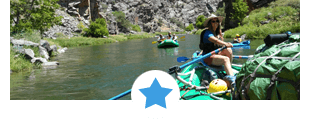The Most Endangered Rivers in the US
10. Clearwater/Lochsa Rivers
Home to the Nez Perce Tribe there are 100 miles of river that is a haven for fish and anglers In Idaho. This same river was traveled by Lewis and Clark as well as declared America’s first Wild and Scenic Rivers in 1968.
Industrialization and highways paralleling these rivers is threatening the health and longevity of the ecosystem with the want to move equipment to Canadian tar sands. The megaloads of equipment needed by wheels or up Snake River to Lewiston, Idaho by barge not only slows down traffic, contributing to smog, but it ruins the aesthetics of the wilderness and if the loads or trucks fall off, they would be near impossible to remove from the river due to their sizes.
The shipment of megaloads along Highway 12 must be banned to save this river.
9. Haw River
The Haw River is based in North Carolina and stretches 100 miles long with a large variety of wildlife that call this area home. Over 1 million people use the water for drinking water and recreation but due to a lowered restrictions to maintaining a clean water supply, pollution is a big threat to this river.
Polluted runoff and wastewater flow regularly into it as the population increases and old pipes are breaking. As a result of all the raw sewage, algae blooms are suffocating the health of the fish and people.
A strong clean-up plan must be executed for the river. Politicians need to focus on this problem and reinstate good policies and push to replace aged pipelines to prevent more raw sewage spills and algae blooms and reduce pollution.
8. White River (Washington)
The U.S. Army Corp’s of Engineers Mud Mountain Dam is contributing to the decline of Chinook, coho, chum, and pink salmon. Steelhead and bull trout are also threatened by this dam and they are critical to the culture of Muckleshoot and Puyallup Indians. The dam is very outdated, especially for fish passage as they die at the fish collection facilities and taxpayers spend $150 million each year to restore the lost salmon. The fish trap here is too small and overcrowded, making the fish exhausted during their 68 mile journey. If they even make it through despite exhaustion or injuries, they are often delayed for breeding.
Updating the structure of the dam so that it is safe for fish, humans, and other animals will go a long way to protecting the wildlife and cut back significantly on wasting taxpayer money on a problem that is easier and cheaper to solve. This will also lower the need for routine maintenance, which cuts off water supply below, leaving juveniles stranded without water to finish their travels to Puget Sound.
7. White River (Colorado)
As a quiet and significant river to the town of Meeker and stretching from the Flat Tops Wilderness Area and stretches 195 miles across northwestern Colorado. There are several endemic endangered fish that live here and used by herds and 7,000 Meeker citizens.
Oil and gas development threaten the fish, wildlife, and drinking supply of Colorado. The Bureau of Land Management is proposing to allow 15,000 new oil and gas wells in this area. These wells, through drilling and extraction, will physically alter the landscape and estimated to drop the deer population dramatically by 30% and destroy the habitat of the greater sage grouse. Fracking is linked to polluting the groundwater of the region as well as air quality.
As drilling will inevitably happen, it’s crucial for the BLM to come up with a plan that will protect the wildlife and ecosystem for future generations. The viewshed of Dinosaur National Monument needs protection and the air and water quality too and expand the viewpoint away from simply focusing on extracting gas and oil for transportation and money.
6. South Fork of the Edisto River
Protecting the water supply is the number one way to save this endangered river in South Carolina. The agriculture industry pulls out 35% of the water during the summer, which is much needed by the land and farms down 250 miles of this river. The South Fork of the Edisto is home to endangered shortnose and Atlantic sturgeon, American shad and striped bass. It’s also one of favorite rivers for South Carolina residents and visitors to paddle, fish, and play in.
Many rivers in South Carolina are not protected from over extraction and everybody suffers as a result. The South Carolina Surface Water Withdrawal, Permitting, Use, and Reporting Act is a step in the right direction to helping these rivers out but the process to withdraw water needs to be stricter and be overlooked to preserve this great river.
5. San Francisquito Creek
Everything around and in this California river is threatened by a very outdated Searsville Dam. It is a wildlife refuge yet the threatened steelhead can’t migrate upstream and the dam could collapse and flood the surrounding area at any time. The many threatened species like steelheads, tiger salamanders, red legged frog, San Francisco garter snake, and western pond turtle use the area around the creek as their habitat and safety is at risk by the dam.
Standford University owns the Searsville Dam an as an educational resource, ought to better understand the threat of an outdated dam to wildlife and nearby communities. The Searsville Alternatives Stdy Steering Committee has been studying and planning what should be done with the dam and will be implemented to save the San Francisquito Creek.
4. Gila River
A free-flowing river in New Mexico, the Gila River is threatened by water diversion projects to capture 14,000 acre-feet of water each year, which doubles the normal amount for crop production. The Gila Wilderness was the first designated wilderness area in the US and the diversion of water will negatively impact this area. The surrounding forests provide a habitat for the birds, one of the highest concentration of breeding birds and recreation for people.
The proposed diversion plan is flawed and would cost 2-3 times more than proposed. Water conservation must be implemented to save ecosystem and recreational tourism. However, there seems to only be the option of diverting water or not diverting it at all.
3. Middle Mississippi River
Spanning across Missouri, Illinois, and Kentucky, the middle section of the Mississippi River faces a threat to a floodplain. The US Army Corps of Engineers wants to cut off the river from one of the few floodplains with a levee at the bottom of the New Madrid Floodway. The floodplains are crucial for the existence of backwaters, wetlands, and sloughs that are home to a wide variety of wildlife and plants. This levee would cut off water supply to 75,000 acres of floodplain habitat and they would quickly cease to exist.
The habitat and public safety from floods through Missouri, Illinois, and Kentucky will persevere so long as the construction of the levee is stopped.
2. Upper Colorado River
Another threatened river in Colorado, the Upper Colorado’s health and recreation is at risk because of heavy degradation and proposed water diversions. The water currently sustains, fish, wildlife, plants, and agriculture along the river itself, attracting tourism and water sports. Ski resorts get their drinking water from here, supporting tourism and the economy.
Water management needs to be updated and improved to meet current and future needs. Economically, water tourism in Colorado brings in multi-billions of dollars in revenue and this can’t continue if water diversion pulls that away.
1. San Joaquin River
California also has another threatened river that tops this list – San Joaquin River. Again, this river suffers from outdated water management and excessive water diversions. As one of the most productive regions in the world, California agriculture, fish, wildlife, and communities depend on the river for survival.
Improving the health of the watershed and increasing water flow in a sustainable manner is what will help this river the most, especially due to harsh hitting droughts.
Read more about these endangered rivers on americanrivers.org.
At Wilderness Aware Rafting our passion is white water rafting, river health, and the outdoors. If you’re interested in a Colorado Rafting Trip, or Salt River whitewater rafting, browse the whitewater rafting trips and other fun outdoor trips we offer.


